她将美好生活编织进彩带
兰伟香
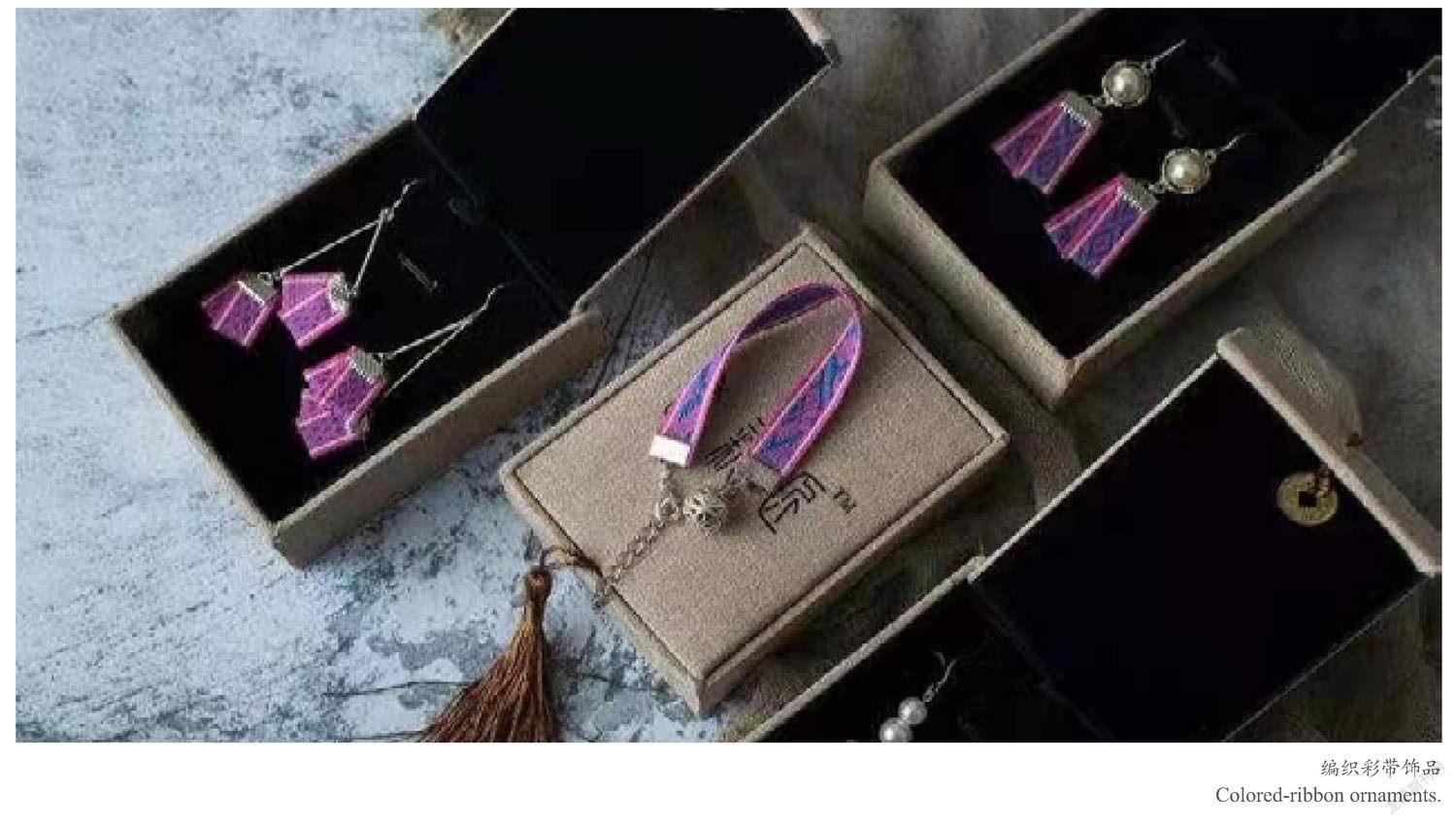
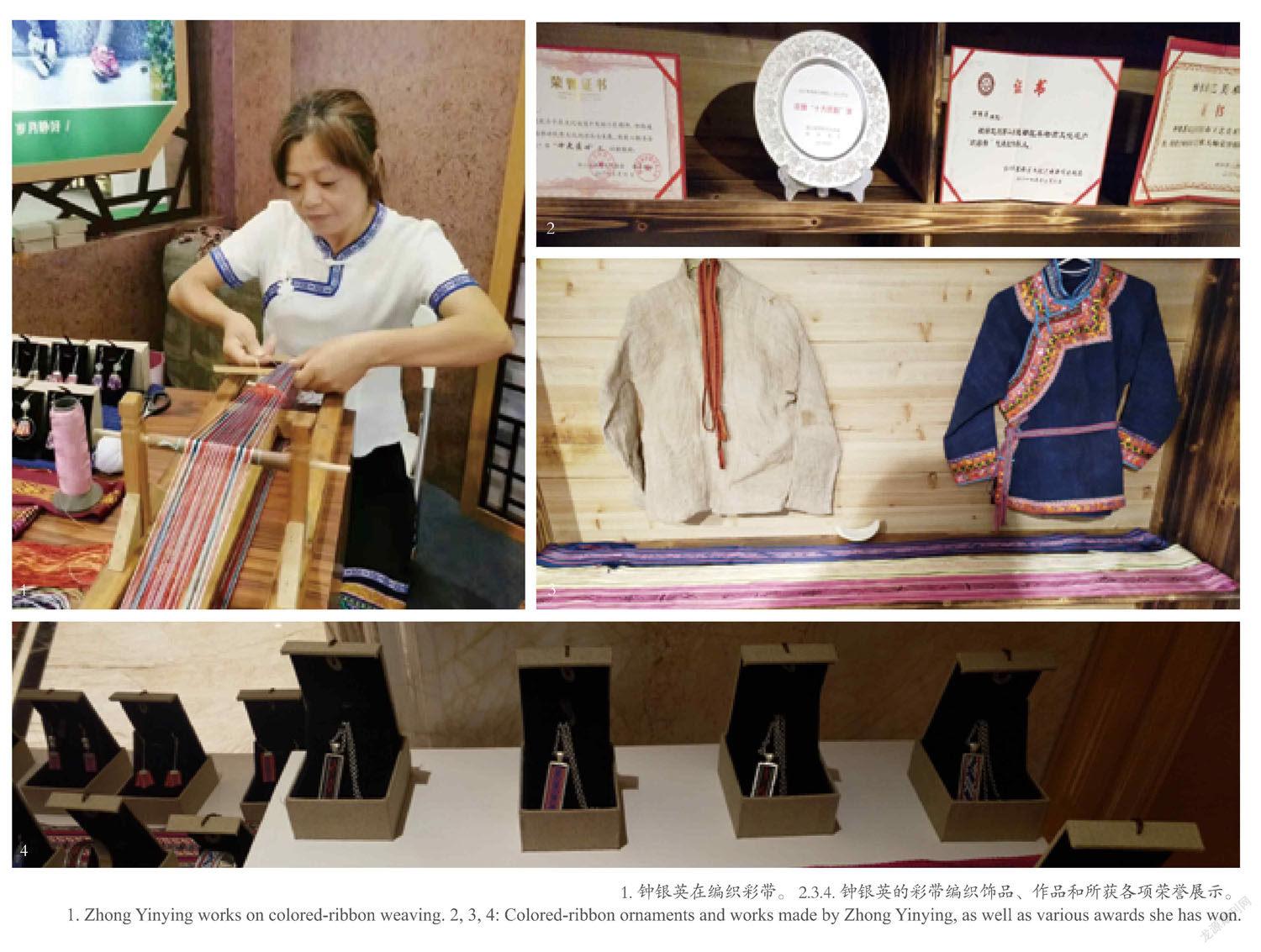
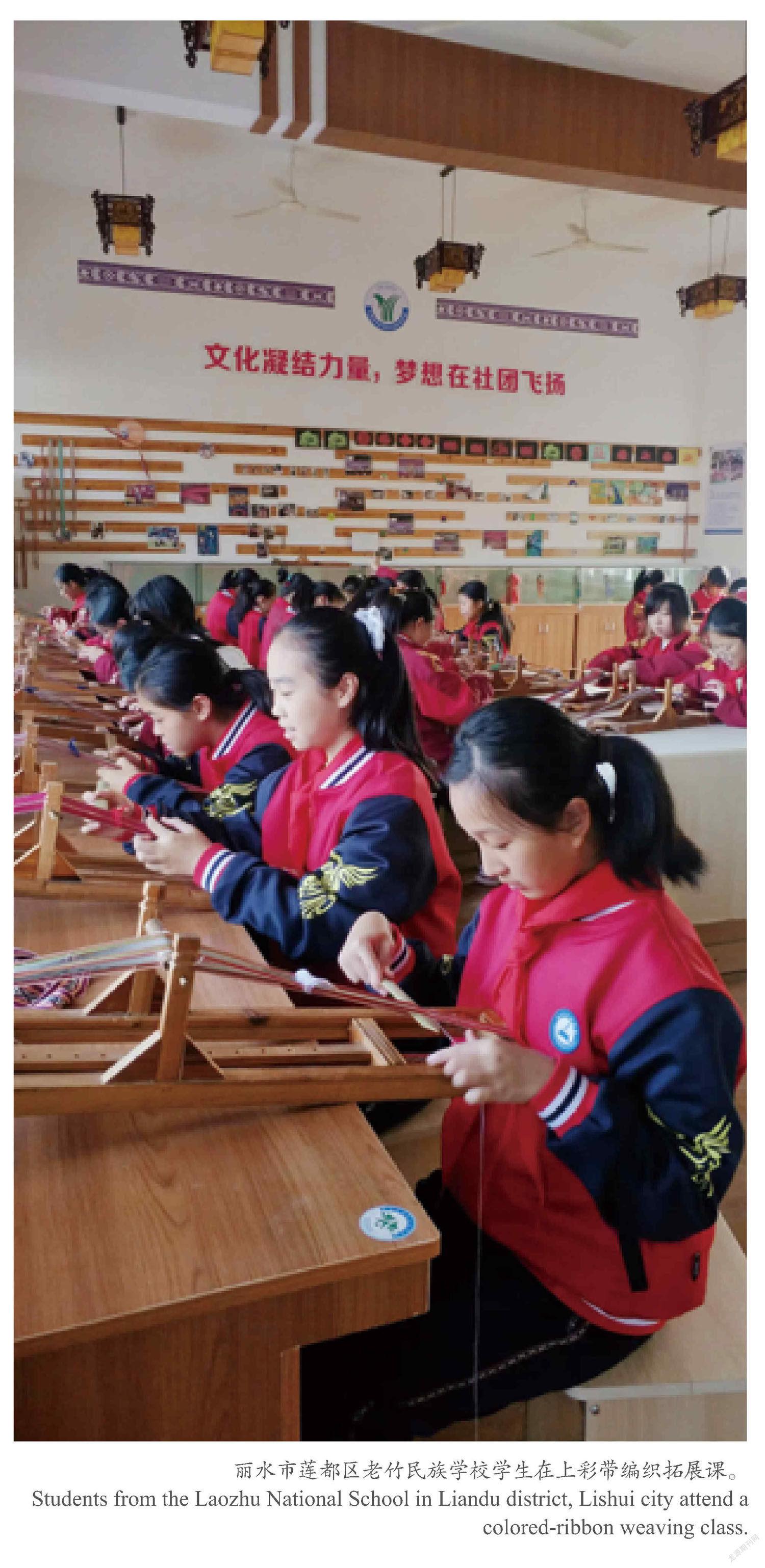
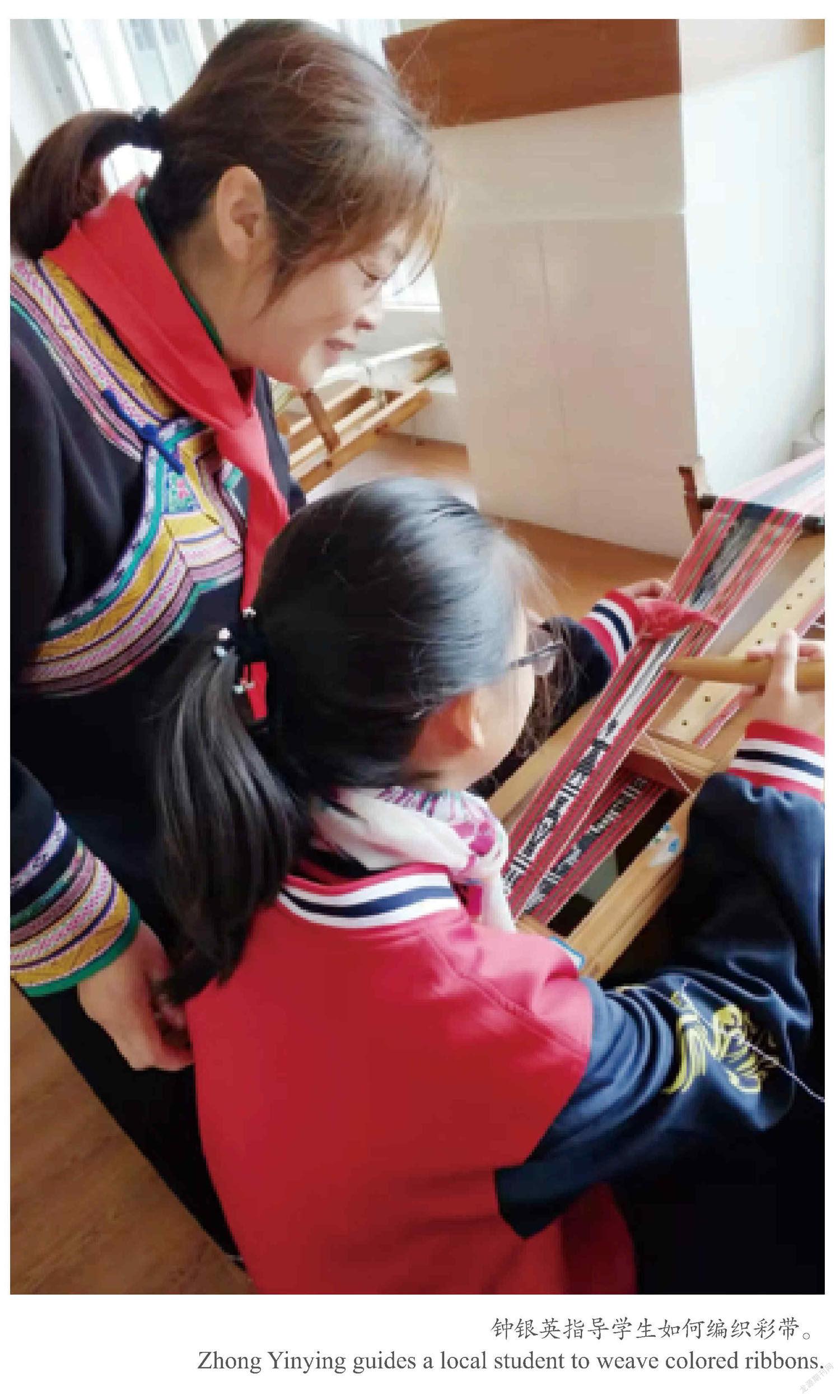

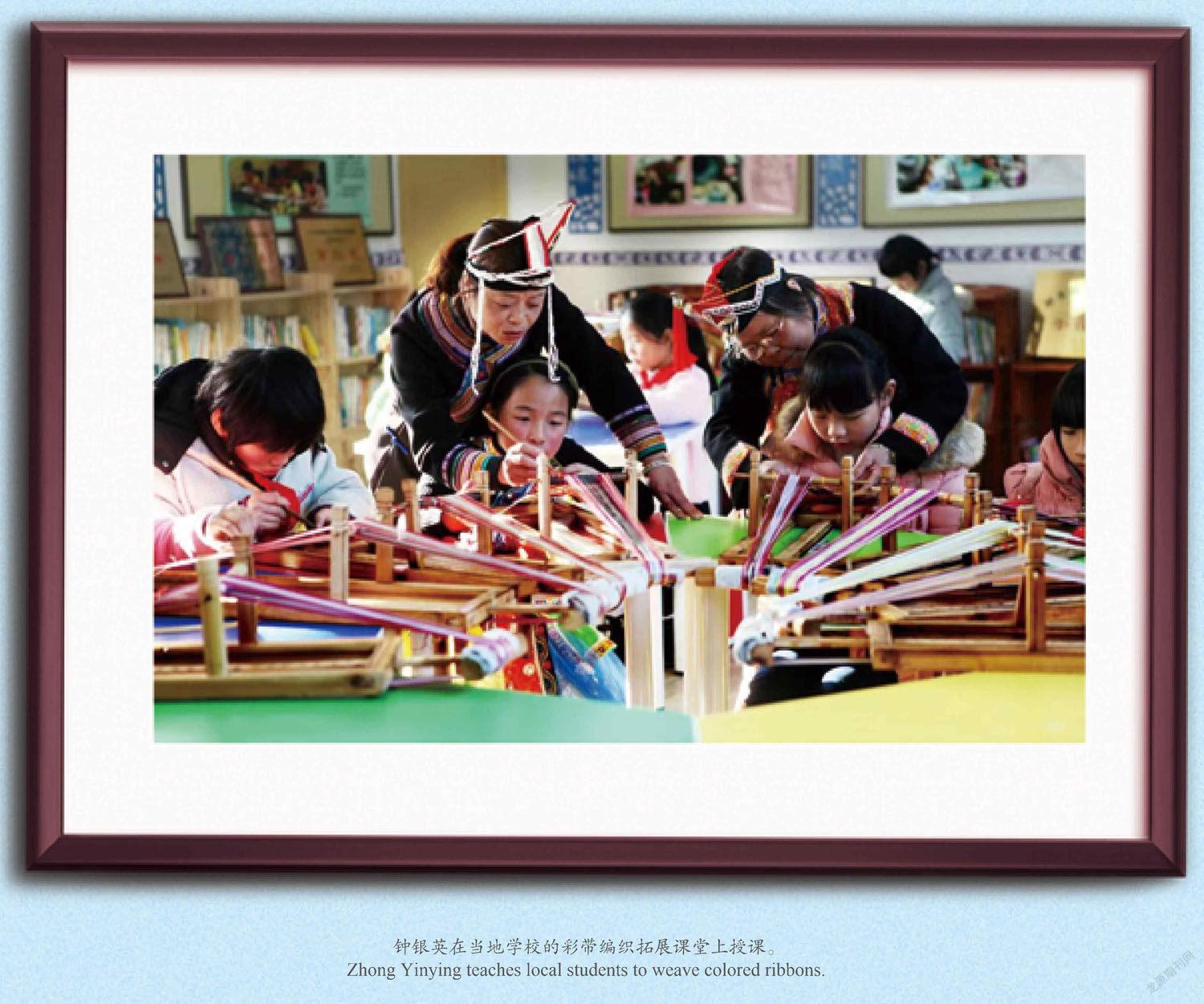
一片竹片、两根竹竿、数条彩线,一端系于腰间,另一端拴在凳脚或者屋柱上。经过配线、整经、做棕、织纹、挑花,一双巧手来回穿梭于丝线之间,一个个具有畲族特色的图案逐渐显现,这是编织畲族彩带的全过程。2020年12月,在全国第五批国家级非物质文化遗产代表性项目名录中,畲族彩带编织名列其中。新春刚过,丽水市非物质文化代表性传承人钟银英又忙开了,对作为非遗传承人的她而言,虽然彩带编织程序繁杂、过程单调,但她却深深地爱上了这门手艺,彩带编织成了她生活的重要部分。
彩带织出美好情怀
钟银英1968年出生在莲都区老竹畲族镇沙溪黄兰自然村一个畲族编织世家,作为非遗传承人,她从小就受长辈们的熏陶,看着身边的人编织各种形式的彩带。“畲族一直有织彩带的传统,它既是一种生活用品,也是年轻姑娘的定情信物。姑娘到十七八岁时,会把自己编织好的彩带送给情郎,定下自己的终身大事。”她总是很好奇,慢慢地,她知道了畲族彩带的故事,了解了畲族彩带上千年的历史,越来越喜欢上这一被畲族人民作为裤带、腰带、拦腰带、刀鞘带等使用的彩带。
“长辈们常常在我耳边唠叨,我们畲族的彩带要失传了,你一定要学起来,把这门手艺传承下去。”钟银英一边看一边学。“刚开始学的时候,我常常弄得手忙脚乱。虽然编织彩带看上去很简单,但织法很独特,要用到多种颜色的经纬线。编织花纹、图案或文字时,很容易搞错,而一出错就白忙活了。”说起彩带编织,钟银英侃侃而谈。
“我经常自己拿线摸索织法,但是经常会织错。”她从最基础的“平纹”开始学,常常一坐下来就是好几个小时,一个符号要摸索半天。就这样拆了织织了拆,反反复复。但是她觉得这是一个熟能生巧的手工活,自己一定能编好。她一点点留意大人们的编织过程,默默地记在心间。
随时随地,一有空闲,钟银英就编织起彩带来。以前农村织彩带没有特制的织带机,屋里屋外乃至山野都可编织。她常常把丝线的一端拴在凳脚、桌档或屋柱上,另一端系在自己的腰间,坐在凳上编织。要是在山野编织,就把丝线的一端拴在小树干或树桩上,另—端仍系在腰身上,坐在地上或跪在地上编织。
“彩带以丝线编织为主,也有用棉纱编织的。”线以红、绿、黄、紫等色线与白线相间,行数随宽窄而定,一般以十三行较普遍。经线多则宽,经线少则窄,宽的有两寸多,窄的不足半寸。不论带子宽窄,穿梭编织花纹图案皆在正中的七根线上,其余的编织平面花边。”一遍遍地尝试后,钟银英掌握了其中的诀窍。“现在我看到别人织的花纹,观察一下我就能知道是多少根线织的、怎么织的,看后自己就可以织出来了。”凭借对彩带编织的喜爱,钟银英不断提高编织技艺,并创新地将彩带花纹与文字相结合。经过几十年的探索,创作出了具有时代性和个人风格的畲族彩带。
“彩带之家”让游客免费体验
钟银英常常思考,如何把这一技艺传承给更多的人。
“现在畲族彩带面临着后继无人即将失传的无奈和尴尬。”彩带成本虽不高,但是靠手工编织,一丝一扣花时多。现代畲族年轻姑娘大多外出经商打工,很少学编织彩带。送彩带的传统族规也逐渐被打破,流传千百年的畲族彩带已不再“风光”。随着现代化的发展,青少年缺少接触畲族传统文化的机会,畲族传承人老龄化严重。
2014年,钟银英被评为“莲都区非物质文化遗产(织彩带)代表性传承人”,2017年,被评为丽水市非物质文化代表性传承人。“成为传承人之后,我觉得肩上的责任更重了。最重要的是对于非遗要没有私心,只要有人来学,我便愿意把我会的都教给他们。但是有些人即使我说是免费教,她们也不愿意学。”钟银英只好从身边的人教起,先教会了自己的女儿、侄女等。
随着东西岩旅游景区的发展,2010年,钟银英将自己家腾出了150多平方米,创办了“彩带之家”工作室,用于展出畲族彩带、服装,体验彩带编织等。
她不断推陈出新,运用畲族彩带的编织技艺手法编织出字带,巧妙地运用到首饰中。把一条彩带剪裁成若干小段,与金属丝等进行组合设计,改造成娇小玲珑的耳饰等。还将畲族彩带运用到畲族传统服装的装饰上。
2017年,因为在文化创意中推动优秀文化的传承与发展,钟银英获浙江省网络文化协会、新浪浙江颁发的“十大匠心”奖。2020年,在首届中国畲族文化创意产品设计展演中,钟银英的畲族特色首饰系列作品获得了三等奖。
为了让更多的人在自己的工作室能快速体验彩带编织,钟银英根据自己的经验设计了彩带支架,大大减少了以往在桌档、屋柱等处织彩带所花费的前期准备时间。双休日,节假日,寒暑假,工作室供学生和游客免费体验,钟银英免费传授彩带编织技艺。
让彩带编织代代相传
在多年织彩带生涯中,钟银英越来越觉得传承的必要性和紧迫性。从2015年起,钟银英被聘为莲都区老竹民族学校、丽新小学彩带编织课程教师。借助学校的平台,每周三,她走进学校的拓展课程课堂,与学生面对面交流,让学生近距离体验、感受畲族彩带这一非物质文化遗产的独特魅力。
同学们总会一边编织畲族彩带,一边向她询问问题。钟银英总是耐心地和孩子们一起研究花纹的编织方法等。7年来,她已将彩带编织技艺传承给了四百多位学生。
莲都区老竹民族学校8年级学生蓝雯悦跟随钟银英学习编织彩带三年,如今她已经能熟练地编织彩带,还能在彩带上编织好看的花纹和图案,如田字、井字、蝴蝶等。她说自己还会将编织好的彩带分享给好朋友,当起小老师教同学们一些入门的技巧。
老竹民族学校副校长李平介紹,彩带编织课程的开设助推了彩带编织技艺的传承,学校充分利用校外资源,邀请非遗传承人钟银英授课,让更多的学生了解畲族的民族文化,培养民族情怀。
钟银英一边授课,一边还着手编写图书。她说,畲族只有语言,没有文字,彩带编织等靠口口相传,多以师传徒、母传女的形式进行传承,她想突破这一局限性。多年来,她一直在寻找能绘图的专业人员帮助绘制畲族彩带的图案。2017年,一次偶然的机会,她将这一想法说出后,得到了同学的女儿张瑞芳的认可,钟银英用了一年时间将彩带编织基本技巧传授给了她。如今,两人正联手将彩带的编织过程,用“图解+文字”的形式写到书本里。她想,不远的将来,会有越来越多的人参照书本自学彩带编织。
一個简单的织带架,一个简易的小梭子,一把色彩斑斓的丝带……钟银英一直在彩带编织之路上不断摸索创新,她把对美好生活的向往密密地编织进了彩带里。
Weaving a Better Life into Colored Ribbons
By Lan Weixiang
With a slice of bamboo, two bamboo rods, and numerous colored threads tied to the legs of a chair on one end and the craftsman’s waist on the other, a pair of deft hands shuttle back and forth. Before long, patterns bearing the marks of the She people appear one by one.
Colored-ribbon weaving, as the craft is known, was added to the list of the fifth group of China’s national intangible cultural heritage in December 2020. It is regarded as a “living fossil” of the She ethnic culture.
It is only a few days after the Chinese New Year celebrations, Zhong Yinying is busy weaving again. As a representative inheritor of the ribbon weaving craft in Lishui city, she is deeply in love with it, despite the complexity and the monotony. Ribbon weaving has become an important part of her life.
Born in 1968 into a weaving family in Laozhu She ethnic township, Liandu district, Lishui city, Zhong has been greatly influenced by her elders since childhood, watching people around her weave colorful ribbons in various forms. “The She people have a long tradition of weaving the colored ribbon, which is not only an article of daily use, but also a token of love for young girls,” Zhong explained. “When a girl turns 17 or 18 years old, she would give her loved one the ribbon she has woven and marry him.”
Zhong has always been full of curiosity, and gradually she got to know the story of the colored ribbon and its thousand-year history, increasingly taken to the item used by the She people as pants belt, waist belt and even scabbard belt.
“I was often told that the She people’s craft of weaving colored ribbons was going to be lost, that I must learn it to pass it on.” Therefore, Zhong observed, and mastered the skills. “I stumbled a lot when I first started. Although ribbon-weaving looks simple, the method is unique, using a variety of colored warp and weft threads. When weaving patterns, designs or words, it’s quite easy to make mistakes, in which case, all your work is wasted,” said Zhong.
She began with the most basic, the plain weaving, often sitting for hours, fumbling for a symbol, woven and unwoven over and over again. But to her, it is a craft that is made perfect by practice. Whenever she had time and wherever the place, Zhong would weave ribbons. In the old days when no ribbon-weaving machine was available in the countryside, she often did her weaving with the threads tied to the leg of a stool or a table on one end and her waist on another. In the mountains, she would tie one end to a tree trunk or stump and the other end to her waist while sitting or kneeling on the ground.
After trying time and again, Zhong got the hang of it. “Now when I see a pattern, I can tell quickly how many threads were woven and how they were woven, and then I can do it myself.” With her love for weaving, Zhong has been constantly improving her skills and innovatively combined patterns with written characters. After decades of exploration, Zhong’s colored ribbons have been full of her personality.
More importantly, she often thinks about how to pass on her weaving skills to more people.
In 2014, Zhong was first awarded the title of “representative inheritor of the colored ribbon weaving craft in Liandu district”, and then in 2017, she became the “representative inheritor of the colored ribbon weaving craft in Lishui city”.
“The craft faces the threat of being be lost,” Zhong said. “After chosen as an inheritor of the colored ribbon heritage, I felt I should do even more on its inheritance.” While weaving colored ribbons costs little, it takes a lot of time. With most young ladies of the She people looking for jobs in urban areas, few have been left to learn the craft. “As long as someone comes to learn, I’m more than willing to teach them. But some people are just not interested even when I teach for free.” Indeed, Zhong had no choice but to teach those around her, first her daughter, then her niece and so on.
In 2010, Zhong set aside a space covering 150 square meters in her own house and turned it into a studio to showcase the colored ribbons and the traditional clothing of the She people, and to invite the ever-growing number of tourists to have a try at and learn the weaving process and skills free of charge. In the past few years, she has also made quite a few innovations to the craft, which helped to win her multiple prizes and awards. One of the innovations that Zhong made, for instance, is that she would cut a regular colored ribbon into smaller sections and, combining them with metal wires, transform them into attractive earrings.
Since 2015, she has been teaching weaving in a couple of local primary and secondary schools; in the past seven years, more than 400 students have taken her classes, learning not only the weaving skills per se, but experiencing firsthand the cultural heritage that lie in the colored threads. Now, Zhong and her daughter are busy writing an illustrated book in Chinese on the craft of weaving colored ribbons — since the She people have no written language, such a book is the best way for more people to learn the skills.
With a simple frame and a simple shuttle, Zhong has woven her hope for a better life into colored ribbons.

